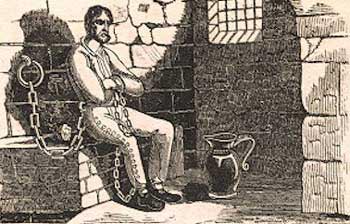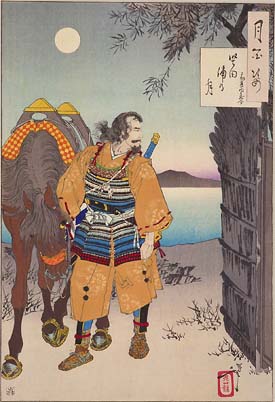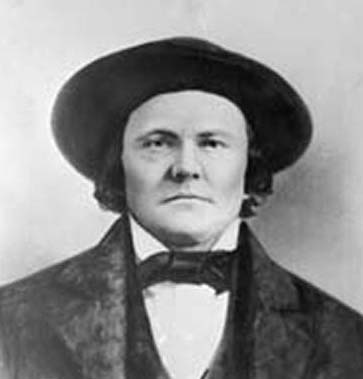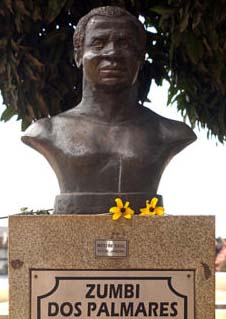
Historical Tales | News | Vampires | Zombies | Werewolves
Virtual Academy | Weapons | Links | Forum
The Top Five Vampire and Zombie Hunters in History
James Godfrey, a.k.a., Machete Jim, Australia
 |
| Machete Jim in jail |
The combination of crowded conditions and infected rats in Australian penal colonies made zombie outbreaks quite common there. On occasion, entire work camps were wiped out by fast-spreading outbreaks. Many camps took to burning the corpses of the recently deceased to insure that they didn't "reawaken" as zombies.
No such precautions were in place at Godfrey's Botany Bay camp on the night of September 14, 1846, when a guard took ill and passed away. The other guards carelessly buried the body near the camp, and one night later, their erstwhile associate awoke as a zombie. The zombie-guard dug his way out of the grave and immediately attacked one of the guards. The other guards fled in terror, leaving the chained prisoners virtually helpless against the rampaging zombie. Only Godfrey remained calm; he managed to get the keys from the dead guard and unlock his chains. He then picked up his machete and hacked the raging zombie into a dozen pieces.
The boss of the work detail was so impressed with Godfrey's courage that he offered him a chance at early release if he agreed to work in zombie extermination. Godfrey seized the opportunity and, over the next few years, displayed a remarkable capacity for zombie killing throughout the local work camps. He could lop off a zombie's arms and head with three whistling swipes from his machete. His skill with the bladed weapons was so great that his cohorts took to calling him "Machete Jim."
After his release, Machete Jim accepted a position with Australia's fledgling Commonwealth Special Investigation Branch, where he eventually rose to commander. He was a man of few words and preferred to lead by example, charging fearlessly into zombie hordes all across New South Wales and Tasmania. He continually refined the undead fighting arts and was one of the first to bring shotguns into common use against zombies.
Machete Jim wiped out an estimated 4,000 zombies during his career. The Duke and Duchess of Cornwall honored the former convict with the Order of Merit during their 1901 visit to Australia. Ten years later, Machete Jim died of natural causes in Sydney, at the age of 88 years.
Toshihiko Kamiyama, Japan
 |
| Toshihiko Kamiyama |
The panicked nobles, in danger of losing their city to the undead, turned to to the only person capable of stopping the vampires: Toshihiko Kamiyama, the greatest samurai of his time. Kamiyama was a legend in Kyoto for his bravery, honor and skill with the sword. At the height of his powers, he had abruptly retired to live a life of monastic devotion at a Shinto temple in the mountains.
Representatives of the nobles journeyed to the temple and pleaded with Kamiyama to help. At first, Kamiyama was reluctant, but he finally agreed on the condition that he be allowed to train his own recruits at the temple without any outside interference. Kamiyama reasoned that fresh recruits would be more teachable than veteran samurai. After selecting 20 of the most promising young martial artists, Kamiyama spent countless hours tutoring the men among the maple and ash tress and the bird songs of the mountain temple. Kamiyama worked his charges on swordfighting arts and conditioning, and he often had them spar with blindfolds on to get accustomed to the art of night fighting.
After a year of training, Kamiyama and his team were ready. They journeyed out of the mountains to Kyoto, established quarters in the mansion of a noble, and prepared their assault. They boldy slipped into Katsumoto's compound at night, when the vampires were out hunting. After killing the civilian guards, Kamiyama and his men changed into the dead guards' armor and waited for the vampires return. When Katsumoto and the vampires returned, full from a night of feeding, Kamiyama and his men set upon them. They slashed and destroyed scores of vampires, and took a few casualties as well. During the fighting, a fire broke out in the compound when a candle ignited some textiles. Katsumoto escaped through a network of secret tunnels. Kamiyama chased him down and they had an epic sword battle as the compound burned around them that is still considered the greatest sword fight ever staged. The fight ended only when Katsumoto fell through a burning floor. No body was ever found, and rumors persist that he is still alive to this day.
Over the next several years, Kamiyama and his men systematically eradicated vampires from Kyoto. The wars that had devastated Kyoto came to an end, and people slowly returned to the city.
With the conflict was over, Kamiyama returned to the mountains and the ascetic lifestyle of a Buddhist monk. Sightings of him were rare. He reportedly died in 1533, at age 100.
Kamiyama destroyed an estimated 1,200 vampires in Kyoto.
John "Red Jack" Averill, United States
 |
| Red Jack |
Red Jack grew increasingly restless in his small Tennessee community and in 1936 traveled to Texas to aid in the revolution, a popular cause among many Americans. He later enlisted in the U.S. army and fought in the Mexican-American war. One night, the troops in Red Jack's platoon were sleeping in the desert north of Mexico City when they were attacked by a pack of vampires. After morning broke, Red Jack discovered a silver mine nearby, went inside with nothing but a sword, and came out holding the heads of several vampires.
Red Jack took his vampire-fighting skills west after the war and hired himself out to clear gold and silver mines of vampires. He was well rewarded for his expertise and, after a few years, was able to open a saloon in the rowdy Barbary Coast area of San Francisco. But vampire slaying was never far from Jack's mind. In 1858, he left San Francisco for Washington D.C. to help the U.S. government with the creation of the Vanguard, the precursor of the FVZA.
Red Jack's work was interrupted when the Civil War broke out in 1861. From 1861 to 1865, he served in the Union and helped troops wipe out packs of vampires from the woods of Virginia to the plantations of Georgia.
Red Jack struggled with a host of demons throughout his life, including alcohol and gambling. In fact, it was Jack's gambling debts that caused him to turn down an offer to join the newly-minted FVZA after the war and instead take a lucrative job with a touring Wild West show, where he performed choreographed battles with actors disguised as vampires.
Red Jack's drinking worsened during the show's 1870 tour of Europe. That winter, he was stumbling back to his hotel in Vienna, Austria, after a night of drinking when a pack of vampires ambushed and killed him. It's doubtful the vampires knew that their victim had killed over 4,000 of their kind during his lifetime.
King Zumbi, Brazil
 |
| King Zumbi |
The man who would one day be known as King Zumbi was born in Palmares in 1635 to an African mother and a deserter from the Portugese army. Zumbi's father trained him in swordfighting and the martial art called capoeira. The boy put his skills to good use during the many zombie outbreaks that afflicted the mocambos. According to local legend, Zumbi killed his first zombie at age 12.
Zumbi grew into a towering, muscular man equally comfortable in hand-to-hand combat and swordfighting. But Zumbi was more than just a brute. He possessed political ambitions as well, and it was his dream to unite the mocambos into one independent nation. His fame spread after he helped other local mocamboes put down zombie outbreaks, and, in 1660, he was selected king of the mocambos. Zumbi proclaimed independence for the mocambos and began carrying out raids against the Portugese. Though militarily disadvantaged, Zumbi and his men knew the jungle and exacted significant losses on the Portugese.
In the summer of 1664, a major zombie outbreak hit the important Portugese settlement of Sao Paolo. The plague spread quickly, and groaning zombies of all sizes and shapes shambled about the city's cobblestone streets. Many Portugese soliders deserted rather than stand up to the terrifying hordes.
Facing the potential loss of a strategically important city, the Portugese reached out to Zumbi and offered him a deal. They would grant independence to the mocambos in return for Zumbi's assistance in putting down the zombie plaque.
For Zumbi, it was a difficult decision. He bore a great deal of hostility toward the Portugese for their legacy of slavery and oppression, but he knew that the mocambos were unlikely to achieve independence without some help. So, after much agonizing, he decided to travel to Sao Paolo.
Zumbi and his most trusted officers arrived in Sao Paolo in September 1664. He trained the Portugese army in different zombie-fighting formations and introduced modified melee weapons for easier decapitation. Zumbi's leadership was inspirational and, slowly but surely, the zombie plague abated. In just six months, order returned to Sao Paolo.
Unfortunately, the Portugese had no intention of letting Zumbi return to Palmares in triumph. During Zumbi's "Going Away" party at the royal palace, the Portugese drugged him and his top officers and locked them in a dungeon with dozens of hungry zombies. The unarmed, groggy men fought courageously, but they were greatly outnumbered and the zombies eventually tore them apart.
The killing enraged the mocambos, and for the next 25 years they waged an almost constant war against the Portugese. But without Zumbi's leadership, they were ineffectual, and the Portugese burned Palmares to the ground.
Estimates put Zumbi's kill count at more than 5,000 zombies. A bust of him adorns the esplanade in Brazil's capital of Brasilia.
Twelve String Digby, England
 |
| Twelve String Digby |
English efforts to fight the vampires mostly met with failure. The vampires changed bases feqeuntly and fought a kind of guerilla warfare for which the English troops were ill-prepared. Stagecoaches and post-boys took to avoiding nighttime travel altogether, a move that severely crimped commerce and communication between London and other cities.
In desperation, the English decided to fight fire with fire and enlist the help of a notorious convict named Digby Wolfe. Wolfe was a flamboyant character who earned his nickname for the habit of decorating his breeches with 12 lengths of colored string. He had spent most of his adult life as a highwayman, or coach robber. His skills on horseback were unmatched, and he eluded the law for many years until his arrest in 1681.
English offiicals reasoned that an experienced highwayman like Digby would be the ideal foil against these roving vampire packs, so they offered him a choice: 20 years at London's notorious Newgate Prison, or service as a vampire slayer for His Majesty Charles II.
As with the legendary Australian Machete Jim, Twelve String Digby chose freedom, and over the next seven years, he led a group of English troops against the vampires. On occasion, Digby and his men hid among the trees, lying in wait for the vampires to attack a passing coach. At other times, he would go undercover as a passenger on a well-appointed stagecoach. When the vampires attacked, he laid waste to them with stunning speed.
Digby cleared vampires from the Hounslow Heath area, and then the Great Dover Road. Nighttime travel around London became (relatively) safe again.
Charles II feted Digby at Whitehall Palace in London, and he became a fixture in social circles, where he developed an affection for married women. Even a bout of venereal disease didn't stop him from pursuing the wives of prominent Brits. Unfortunately for him, one of his conquests was married to a notably jealous lieutenant-colonel who discovered the affair and challenged Digby to a duel at Hogsden Fields. Normally, Digby was an accurate shot with a pistol, but he was weakened with VD and missed his first shot. The lieutenant colonel was not so inaccurate, and Digby fell, mortally wounded with a gunshot to the chest. He bled to death in the snow, and England had lost its greatest vampire hunter, a man who killed more than 1,000 bloodsuckers in his time.